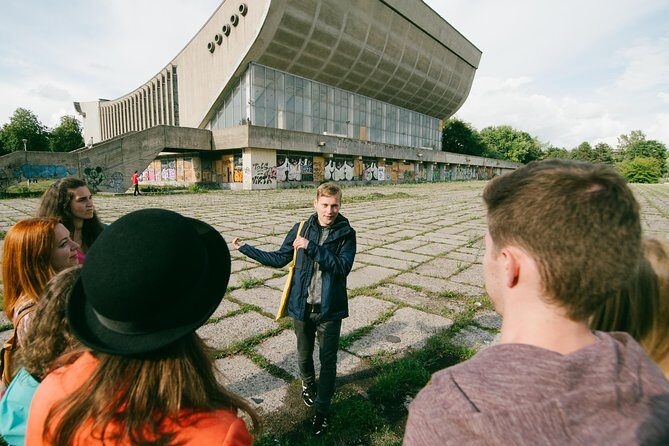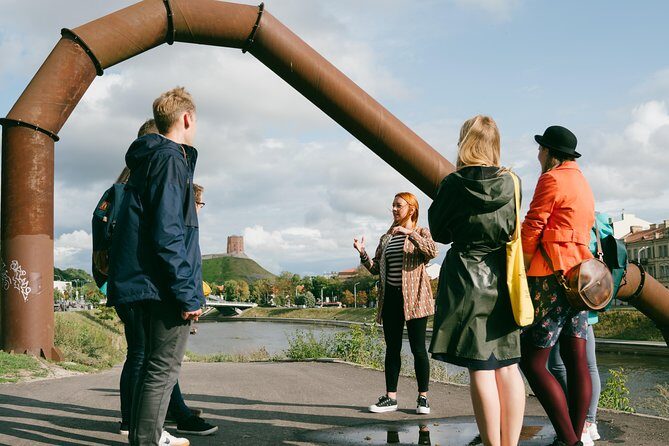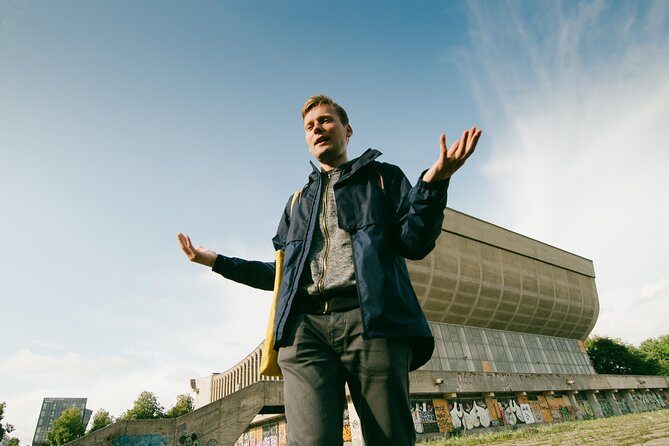Exploring Vilnius’ Soviet Era: A Walking Tour That Brings History to Life
Vilnius, Lithuania’s charming capital, is a city layered with stories—its streets whisper tales of resilience, history, and change. For those curious about the Soviet years that shaped this city, a regular walking tour of Soviet Vilnius offers a compelling and insightful journey. With a price tag of just over $23 per person for about 2 to 2.5 hours, this guided walk takes you from the bustling Cathedral Square to the shadowy halls of the former KGB headquarters, passing through iconic Soviet-era buildings that speak volumes about Lithuania’s recent past.
What we love about this experience is the personal touch of guides who are often locals, sharing stories that make history feel immediate and real. The tour’s focus on landmarks like Lukikiu Square, the Gediminas Monument, and the Palace of Concerts and Sport provides a tangible sense of what life was like under Soviet rule, especially when paired with the guides’ enthusiastic storytelling. Plus, at just under 25 dollars, it’s a surprisingly budget-friendly way to get a meaningful overview of Vilnius’ complex history.
One consideration is that the tour involves a fair amount of walking, about 2 hours or more, so comfortable shoes are a must. Also, some travelers with prior knowledge of the Cold War may find the content more superficial, but for most, the stories and sights add a valuable perspective.
This tour suits history buffs, first-time visitors wanting context for Vilnius’ architecture, or anyone interested in Lithuania’s path to independence. If you’re looking for a personal, well-informed introduction to the Soviet period that’s both educational and engaging, this walking tour will serve you well.
This experience made our article of 16 Fantastic Tours In Vilnius.
Key Points

Engaging Guides: Guides like Tadas and Vilius share personal stories that bring history alive.
Affordable Value: At around $23, this tour offers a lot of insight into Lithuania’s Soviet past for a modest price.
Iconic Sites: Highlights include the KGB headquarters, Gediminas Monument, and Soviet architecture.
Authentic Experience: You’ll walk through the streets where history happened, not just read about it.
Educational Focus: The tour emphasizes understanding daily life under Soviet rule and Lithuania’s fight for independence.
Walking Intensity: Expect a good amount of walking, so wear comfortable shoes and be prepared for weather conditions.
In-Depth Review of the Soviet Vilnius Walking Tour
If you're drawn to exploring Vilnius on foot, we've looked into these other walking experiences
Introduction to the Experience
Starting in front of the Gediminas Monument in Cathedral Square, this tour offers an accessible entry point into Lithuania’s Soviet history. For just over $23, you gain nearly 2.5 hours of guided exploration that covers each major landmark with a focus on the city’s Soviet period. With a maximum group size of 15 travelers, you’re assured a more personal experience, where questions are encouraged and stories flow naturally.
We appreciated how the guides, especially those with personal or local experience, could relate historical facts to current-day Vilnius. The tour is designed for those who want to understand the city beyond its picturesque Old Town—delving into the stories of occupation, resistance, and eventual independence.
The Itinerary and Key Stops
1. Meeting at the Gediminas Monument
This statue is a symbol of Vilnius and Lithuanian sovereignty. The guide provides a quick introduction to the city’s history and sets the tone for what’s to come. It’s a natural gathering point, easily accessible and central.
2. Lukiskiu Square and the Green Bridge
On our walk, we passed the Green Bridge, famous for Soviet propaganda sculptures until they were removed in 2015. Our guide explained the fate of these statues, which adds a layer of understanding about how symbols of Soviet power have been handled post-independence. This stop offers a glimpse into the interplay of memory and history.
3. The Former KGB Headquarters
Arguably the tour’s highlight, the KGB building reveals the darker side of Soviet control. Our guide shared stories about spies and surveillance, making the experience more vivid. Several reviews note the value of guides who can tell personal stories, and ours didn’t disappoint—adding depth and emotional resonance to the visit.
4. Soviet Architecture and Cultural Sites
We saw the Palace of Concerts and Sport, a grand but somewhat faded relic of Soviet-era ambitions, and the House of Scientists, which embodies the architectural style of the time. The guide pointed out how these buildings reflect Soviet ideology—massive, utilitarian, yet often surprisingly ornate.
5. Key Historical Events – January 1991
Our walk touched on the pivotal events of Lithuania’s fight for independence, especially the January 1991 clashes. The guide explained how basketball became a symbol of national pride and resistance, a detail that resonated with many travelers. You might find this historical context enriches your understanding of today’s Lithuania.
6. Kudirkos Square and Ending Point
The tour concludes in Kudirkos Square, a short walk from the start. Travelers can reflect on what they’ve seen and perhaps plan follow-up visits to sites like the KGB Museum or more of Vilnius’ historic neighborhoods.
What Makes This Tour Stand Out?
The real strength of this tour lies in the guides’ storytelling ability. Multiple reviewers praise guides like Vilius and Indres for sharing personal stories, making the history feel alive. One traveler quoted, “Guide provided very clear descriptions of what life was really like in the Soviet years,” adding that the honest and direct tone created a powerful experience.
Another reviewer remarked, “Our guide was a student of history born in the year Lithuania achieved independence,” which highlights the authenticity and immediacy that guides often bring. This personal connection transforms a simple sightseeing walk into an emotionally impactful experience.
The Balance of Content and Walk
While the tour provides a solid overview, some travelers with prior knowledge may find parts of it superficial. As one reviewer noted, “There isn’t enough to justify the nearly 3-hour duration,” especially if you’re already familiar with Cold War history. However, for most, the curated sites and stories provide a clear picture of Lithuanian life under Soviet rule, especially when explained by the enthusiastic guides.
The walking is moderate, and most find it manageable, even in inclement weather, given the tour operates year-round. Just remember to wear comfortable shoes and dress appropriately for the weather.
- Regular walking tour of Soviet Vilnius
- Private Day Trip to Anyksciai and The Hill of Crosses from Vilnius
- Hot air balloon flight over Vilnius or Trakai in Lithuania
- Private Jewish Vilnius Tour
- Tour to Ponary Memorial Park, The Hill of Angels & Trakai Castle
- Hot Air Balloon Flight Over Vilnius or Trakai(transfer included)
Value for Money
At $23.17, this tour offers excellent value. It’s packed with sights, stories, and insights that would be difficult to gather alone. For independent travelers, it’s a way to gain a nuanced understanding of Vilnius’ recent history without spending a fortune. The inclusion of a professional guide and key landmarks makes it a practical yet enriching choice.
Who Should Consider This Tour?
This experience is perfect for history enthusiasts, especially those interested in Cold War stories and Soviet architecture. It suits travelers who appreciate authentic, guided insights into local history and who don’t mind walking. If you’re seeking a deeper understanding of Lithuania’s fight for independence, this tour provides meaningful context that complements visits to museums or other memorials.
Final Thoughts

The Regular Walking Tour of Soviet Vilnius provides a well-rounded, accessible introduction to Lithuania’s Soviet past. With knowledgeable guides, engaging stories, and a carefully curated route, it offers more than just sightseeing—it’s a chance to understand how history shaped the city and its people. While it might not satisfy every history buff’s craving for detail, it strikes a good balance of depth, authenticity, and affordability.
For anyone visiting Vilnius and wanting to go beyond the surface of its charming streets, this tour reveals the stories that people lived through—adding layers of meaning to your visit. Whether you’re a first-time visitor or a seasoned traveler, it’s a worthwhile experience that will leave you with a richer sense of Vilnius’s resilient spirit.
FAQ

How long is the tour?
The tour lasts about 2 to 2.5 hours, covering several key sites and stories about Soviet Vilnius.
Where does the tour start?
It begins in front of the Gediminas Monument at Cathedral Square, a central and easily accessible location.
Is there a group size limit?
Yes, the tour is limited to a maximum of 15 travelers, ensuring a more personal experience.
What should I wear?
Comfortable shoes are recommended, especially since there’s a good amount of walking involved. Dress for the weather.
Does the tour operate in bad weather?
Yes, it runs in all weather conditions, so be sure to dress appropriately for rain, cold, or sun.
Are admission tickets included?
Yes, the tour price includes all tour-related admissions, such as to the KGB building and other sites.
Can I cancel if I change my mind?
Absolutely. You can cancel for free up to 24 hours before the tour starts, receiving a full refund.
Is this suitable for all ages?
Most travelers can participate, but the walking and historical content are best suited for those with an interest in history and good mobility.
Are guides knowledgeable about the history?
Yes, reviews consistently praise guides for their knowledge, storytelling ability, and personal insights, making the experience memorable.
To sum it up, if you’re eager to understand Vilnius’s recent past through authentic stories and significant sites, this tour offers great value in a friendly, manageable package. It’s an ideal way to deepen your appreciation of Lithuanian history, especially if you’re curious about how a city and country found its voice after decades of occupation.
More Walking Tours in Vilnius
- Jewish Heritage in Vilnius – Private Walking Tour
- Vilnele River Walking Tour and Uzupis Experience
- The Majestic and Royal Vilnius Private Walking Tour
- Soviet Times in Vilnius – Private Walking Tour with Lunch
- Vilnius : Sightseeing Walking Custom Tour with a Local Guide
- Vilnius: Regular Walking Tour of Soviet Vilnius
More Tours in Vilnius
More Tour Reviews in Vilnius
More Vilnius experiences we've covered
- Vilnius’s 16 Best Walking Tours
- 16 Fantastic Tours In Vilnius
- 7 Best Private Driver Services In Vilnius (With Prices)
- 6 Best National Park Tours In Vilnius (With Reviews & Prices)
- Vilnius’s 6 Top Historical Tours (With Prices)
- Vilnius’s 10 Top Full-Day Tours
- Our 5 Favorite Vilnius Drinking Tours
- 13 Best City Tours In Vilnius (With Prices)
- Which Vilnius Bike Tours To Choose? Our Best 11 Picks
- Vilnius: Soviet Vilnius Bike Tour
- Vilnius: Trakai Tour with Audio Guide and Minibus Transfers
- Vilnius: 2-Hour Private Vilnele River Canoe Trip
